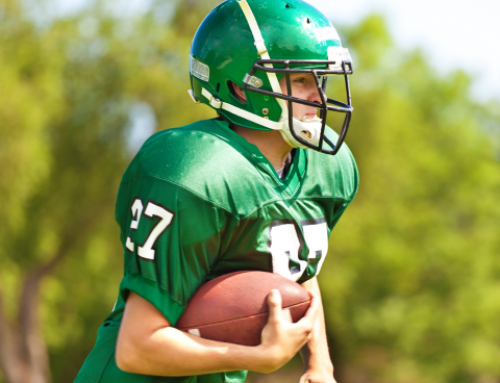STACK Science: How Knee Injuries Occur and How to Prevent Them

Knee Anatomy
To connect the upper leg to the lower leg, the knee links the femur, tibia and fibula bones. The femur and tibia connect with each other through the meniscus, cartilage that acts as a pad between them to reduce force and friction. While the limited contact area allows for a large range of motion, the knee joint primarily relies on ligaments and muscles for support and stability.
The four major ligaments of the knee are:
- Anterior Collateral Ligament [ACL] – Prevents the lower leg from sliding forward relative to the upper leg
- Posterior Collateral Ligament [PCL] – Prevents the lower leg from sliding backward relative to the upper leg
- Medial Collateral Ligament [MCL] – Prevents the knee from collapsing inward
- Lateral Collateral Ligament [LCL] – Prevents the knee from collapsing outward
Lower body muscles play a critical role in knee stability. They are also able to move the joint. The quadricep muscle connects to the lower leg through the patellar tendon, which crosses over the front of the knee and helps to straighten the joint to extend the leg. The hamstring muscles cross over the back of the knee and flex the joint to bend the knee.
Types of Injuries
Knee injuries can occur from contact—such as a tackle or body check—or from non-contact, such as landing from a jump, decelerating or changing direction. The most common knee injury is damage to a ligament, classified as Grade I [minor damage] through Grade III [complete tear or rupture]. Athletes often suffer from O’Donoghue’s Unhappy Triad, which involves an initial tear to the MCL, immediately followed by tears of the ACL and meniscus.<2>
Other injuries, affecting the meniscus, patellar tendon or other supporting structures, can result from improper technique, overuse, natural wear and tear or genetics.
How to Prevent Knee Injuries
Obviously it’s impossible to completely eliminate knee injuries, but athletes can take proactive steps to keep their knees healthy and strong. Follow these three guidelines in your training program:
- Develop lower body strength for additional joint stability. The hamstrings are a particular cause for concern, because weakness there is associated with a higher probability of ACL injuries. Perform exercises like Squats, Deadlifts and RDLs, which develop the quads, hamstrings and other lower body muscles for balanced muscle strength.
- Develop proper technique for running, jumping and other lower body skills
- Perform plyometric exercises to improve technique and muscle power, teaching muscles to fire and stabilize the joint immediately after the foot touches the ground.
Sources:
<1> Senter, C., & Hame, S. [2006]. Biomechanical Analysis of Tibial Torque and Knee Flexion Angle: Implications for Understanding Knee Injury. Sports Medicine, 635-641.
<2> Shelbourne, K., & Nitz, P. [1991]. The O’Donoghue triad revisited: Combined knee injuries involving anterior cruciate and medial collateral ligament tears. The American Journal of Sports Medicine, 474-477.
RECOMMENDED FOR YOU
MOST POPULAR
STACK Science: How Knee Injuries Occur and How to Prevent Them

Knee Anatomy
To connect the upper leg to the lower leg, the knee links the femur, tibia and fibula bones. The femur and tibia connect with each other through the meniscus, cartilage that acts as a pad between them to reduce force and friction. While the limited contact area allows for a large range of motion, the knee joint primarily relies on ligaments and muscles for support and stability.
The four major ligaments of the knee are:
- Anterior Collateral Ligament [ACL] – Prevents the lower leg from sliding forward relative to the upper leg
- Posterior Collateral Ligament [PCL] – Prevents the lower leg from sliding backward relative to the upper leg
- Medial Collateral Ligament [MCL] – Prevents the knee from collapsing inward
- Lateral Collateral Ligament [LCL] – Prevents the knee from collapsing outward
Lower body muscles play a critical role in knee stability. They are also able to move the joint. The quadricep muscle connects to the lower leg through the patellar tendon, which crosses over the front of the knee and helps to straighten the joint to extend the leg. The hamstring muscles cross over the back of the knee and flex the joint to bend the knee.
Types of Injuries
Knee injuries can occur from contact—such as a tackle or body check—or from non-contact, such as landing from a jump, decelerating or changing direction. The most common knee injury is damage to a ligament, classified as Grade I [minor damage] through Grade III [complete tear or rupture]. Athletes often suffer from O’Donoghue’s Unhappy Triad, which involves an initial tear to the MCL, immediately followed by tears of the ACL and meniscus.<2>
Other injuries, affecting the meniscus, patellar tendon or other supporting structures, can result from improper technique, overuse, natural wear and tear or genetics.
How to Prevent Knee Injuries
Obviously it’s impossible to completely eliminate knee injuries, but athletes can take proactive steps to keep their knees healthy and strong. Follow these three guidelines in your training program:
- Develop lower body strength for additional joint stability. The hamstrings are a particular cause for concern, because weakness there is associated with a higher probability of ACL injuries. Perform exercises like Squats, Deadlifts and RDLs, which develop the quads, hamstrings and other lower body muscles for balanced muscle strength.
- Develop proper technique for running, jumping and other lower body skills
- Perform plyometric exercises to improve technique and muscle power, teaching muscles to fire and stabilize the joint immediately after the foot touches the ground.
Sources:
<1> Senter, C., & Hame, S. [2006]. Biomechanical Analysis of Tibial Torque and Knee Flexion Angle: Implications for Understanding Knee Injury. Sports Medicine, 635-641.
<2> Shelbourne, K., & Nitz, P. [1991]. The O’Donoghue triad revisited: Combined knee injuries involving anterior cruciate and medial collateral ligament tears. The American Journal of Sports Medicine, 474-477.










